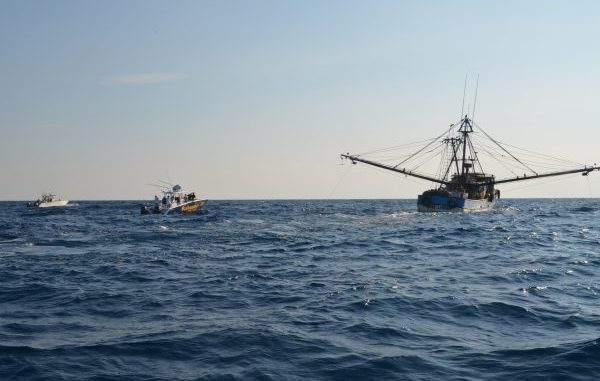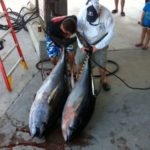
Catching tuna behind hulking shrimp boats is an annual fall bonanza.
Kim Fouquier had the nose of our 29-foot Twin Vee Catamaran in the armpit of the huge 90-foot steel shrimp trawler, putting our bow tightly into the spot on the metal beast where its big outriggers sprang from its hull.
Its heavy engines roared, straining to pull its funnel shaped nets along the sea bottom 232 feet below, and pungent diesel smoke filled our nostrils. The thick steel cables connecting the trawl to the outrigger hissed at the point where they sliced through the water.
Is this any place for a sport fisherman to be?
It is if he wants to catch yellowfin tuna and it’s October.
A year before, Elliot Sale, fishing on this very same boat owned by Kim and Blake Fouquier, caught a 251-pound yellowfin tuna in West Delta Block 122. It was a new Louisiana state record for the species.
Amazingly, another angler on the boat hooked a 191-pounder at the same time, and the crew managed to put both fish in the boat, a remarkable feat for fish so big.
That explained why I was here. The Fouquiers had to be good to do that.
An hour and forty-five minutes earlier, at 5 a.m., I met the crew at the marina at Grand Isle. It was a weekday and it was October, so the marina was deserted.
There were six of them: Blake Fouquier, a 28-year-old oilfield tool salesman; his 57-year-old father Kim Fouquier, an anesthetist; 27-year-old William Fouquier, Kim’s nephew and a medical records technician; Dale Landry, 60, Kim’s lifelong fishing and hunting buddy and a registered nurse; Alex Dubois, 25, a Halliburton field engineer; and, Eric Brown, 26, a rice, crawfish, and soybean farmer.
All of them were from New Iberia, except Brown, who hailed from Jennings.
We left in the dark, headed offshore and southeast, to the West Delta Blocks. At 6:15, Blake slowed the boat to a stop in the dim light of sunrise and scanned the horizon for the silhouettes of working shrimp boats.
Spying one in the distance, he rapidly closed in on the vessel, the Miss Theresa, out of Bayou La Batre, Ala. The deeply tanned and intense young man sprang into action as they neared the vessel. He managed the boat’s controls, prepped rods and began assigning duties to the others like a good deck boss.
Chumming them up
Containers of chum were hauled out and three of the men began liberally tossing handfuls of the offal to within feet of the shrimp boat. Their goal was to lure tunas that have been cruising under the big shrimper out to where baited hooks can be presented to them.
Quickly, shadowy shapes streaked out into the open and smashed the fish parts and pieces, some of them as soon as they hit the water. While the others were chumming, a couple of the men baited circle hooks with live pinfish and mullet. Some were hooked near the tail, others through the mouth.
The rods were inserted in the boat’s rod holders and enough line was stripped from the reels to allow the baited hooks to be hand-tossed near the aggressively feeding tuna. They were fished completely free line, with no weight or other encumbrance. As soon as the bait hit the water, more line was stripped hand over hand from the reel to provide slack.
“You don’t want the fish to see any tension on the bait,” explained Blake.
When a baited hook wasn’t taken and fell to the rear of the paired shrimp vessel and fishing boat, it was quickly retrieved and presented again. That didn’t happen on this pass, though.
Two fish quickly took baits and their reels were slammed into gear. Both rods arched over deeply with hard-charging tunas on the hooks.
Blake took the boat out of gear and the shrimper, who was running at 3 knots, surged away from the anglers. If they were lucky, the fishermen would pull the school of frenzied tuna with them and catch several more of the voracious fish.
If they weren’t, they would catch either or both of the hooked fish and then run to the shrimp boat for another pass.
They hoped they were on their way to a better day then the previous day, when they caught 17 yellowfin and three blackfin tuna, and were done by 9 a.m.
One of the hook-ups pulled loose, but Brown, the hulking crawfish farmer, made short work of his 65-pound yellowfin tuna. During the battle, another sportfisher pulled in on the shrimp boat, just as our boat had done, and with similar results.
“The competition with other boats out here gets pretty tough,” grimaced the younger Fouquier. Indeed, it did. At one time, I counted seven other fishing boats working the same trawler.
No time to waste
The Fouquiers didn’t take time to clean the boat of blood between each fish, a sacred act for most recreational fishermen fishing from white, fiberglass hulls.
“It takes too much time,” explained Blake. “You need to pay attention to keeping the fish on the side of the boat. You can always clean the boat on the way in. It may take more manpower, but it does come off.”
Tuna have to be caught and caught fast before competition from the other boats pulls all the tuna from under the trawler and disperse them.
After boating 20 quick tuna the day before, the interior of the boat looked like an abattoir, bathed in blood. When the action is fast enough, the men don’t even have time to ice the fish as they catch them.
“Fish hard; fish fast; fish now,” seemed to be their motto.
Yellowfin tuna are the preferred species, although the men kept blackfin tuna, a smaller species, as well. As the tuna hit the deck, Blake bled them by deeply inserting a knife blade into their bodies immediately behind one pectoral fin.
“That is where the heart is,” explained Blake. “Some people pull the heart out. Bleeding cleans up the meat. The more blood removed, the better the meat quality. Bleeding is more important for blackfin tuna than yellowfins.”
Bonita, the Louisiana name for little tunny, a tuna relative, are also a frequent catch. These don’t go to waste. Tuna fishermen can never have too much chum. Blake Fouquier expertly cut the bodies of each bonita in a cross-hatched pattern with a razor sharp knife. The resulting cubes of bloody flesh were “filleted” off of the frame of the fish and used to lure more of their cousins to their doom.
“Highly organized chaos” is the best way to describe the way this crew fished. At any moment, Kim Fouquier and Eric Brown would be slinging chum, William Fouquier and Alex Dubois would be baiting hooks and tossing them toward striking fish, all the while stripping line like mad to allow the baits to swim naturally.
Blake Fouquier would be everywhere, running the boat and at the same time feeding chum to the fish, baiting hooks, and stripping line.
Off in one corner, sat their sixth man. Dale Landry had a bemused grin on his face.
He was enjoying the spectacle.



